Project Bayern-21
In this article, we’d like to go somewhat deeper into the age structure of Bayern’s squad and compare it with current competition, previous Bayern sides and also earlier Ancelotti teams.
The Euros boosted expectations
In summer, the level of expectation and anticipation among Bayern fans was close to fever pitch. The two starlets, Kimmich and Coman, had both been given plenty of minutes (390 and 272) and had put in strong performances.
This was also accompanied by the rising star of the Euros: Renato Sanches. The 19-year-old Portuguese had, in his six appearances for the eventual champions, almost completely won over the entire German back pages with his dribbles through midfield and his constant threat going forward. While after he signed for Bayern in May 2016 there was still some criticism about the reported fee of €35 million (plus bonuses), his arrival was met with eager anticipation.
And yet the “established” young players who had put in impressive performances under Guardiola, as well as new signing Sanches, weren’t able to build on their showings from the previous year when it came to the new season under Ancelotti.
Here they were caught a little bit in a vicious cycle. Ancelotti often relied on the spine of his team and would only make a sub when he was losing control of the game. So the young players would regularly come into the games without any rhythm, and often tried to do too much. The weak performances that resulted from that diminished their already low confidence.
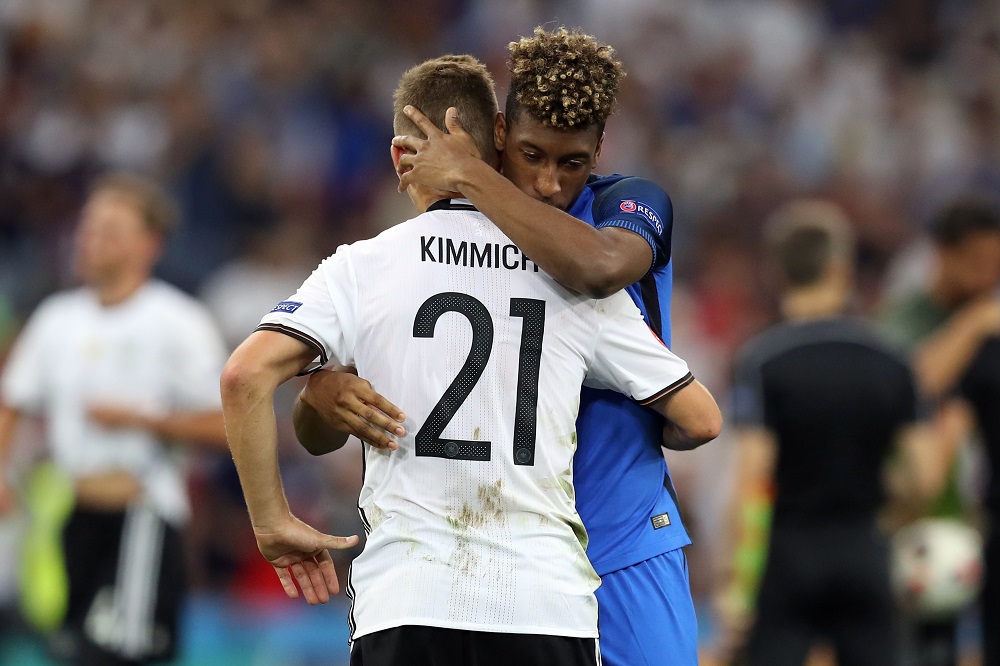
(Photo: VALERY HACHE/AFP/Getty Images)
Kimmich and then not much else
To make it clear how Bayern’s squad is structured in terms of age, we’ve looked at the percentage of each player’s game time and put that with the age of the players. For more clarity, we also added a trend line which shows the average game time per age. Since Philipp Lahm and Xabi Alonso will be retiring at the end of the season, we’ve also included a version of the trend line without the two of them (green). The numbers were calculated on the 26th of March.
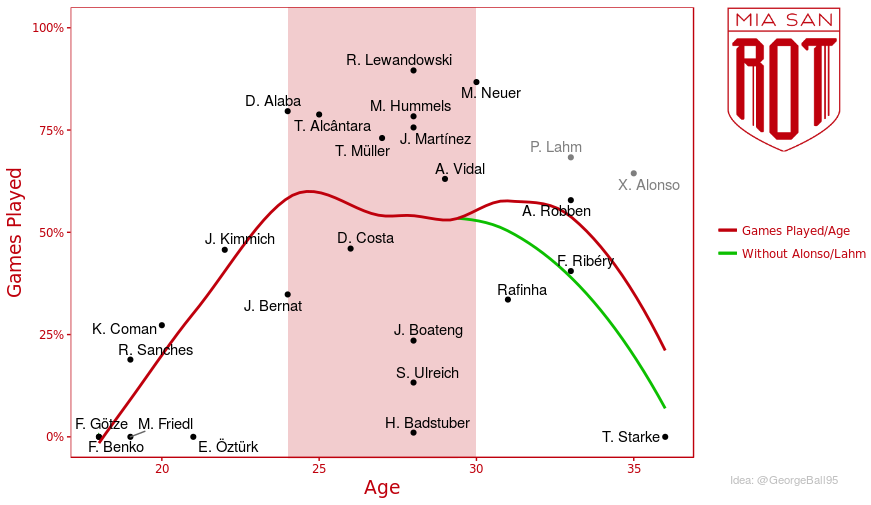
Of the four, Kimmich played the most. Above all, that can be traced back to his versatility, with the youngster appearing in as many as five different positions in total. And yet his strong rate of 50% of minutes is a bit deceptive. The German international’s appearances mostly came in the first part of the season. While Kimmich got 271 minutes in five Champions League games in the group stages, only three games in the knock-out phase followed with 49 irrelevant minutes.
A lack of regular game time was notable in Kimmich’s displays at times. In early autumn he was given 90 minutes in three games in a row against Hamburg, Cologne and Frankfurt, and scored in each game. In the second half of the season, those dangerous forays into the area were rarely to be seen.
Coman and Sanches, meanwhile, each played roughly 25% of the available minutes, with Coman missing several games on account of several injuries. However, just two appearances for the full ninety and only 34 minutes in the Champions League didn’t offer enough potential for development to the Ribery successor which will soon be necessary.
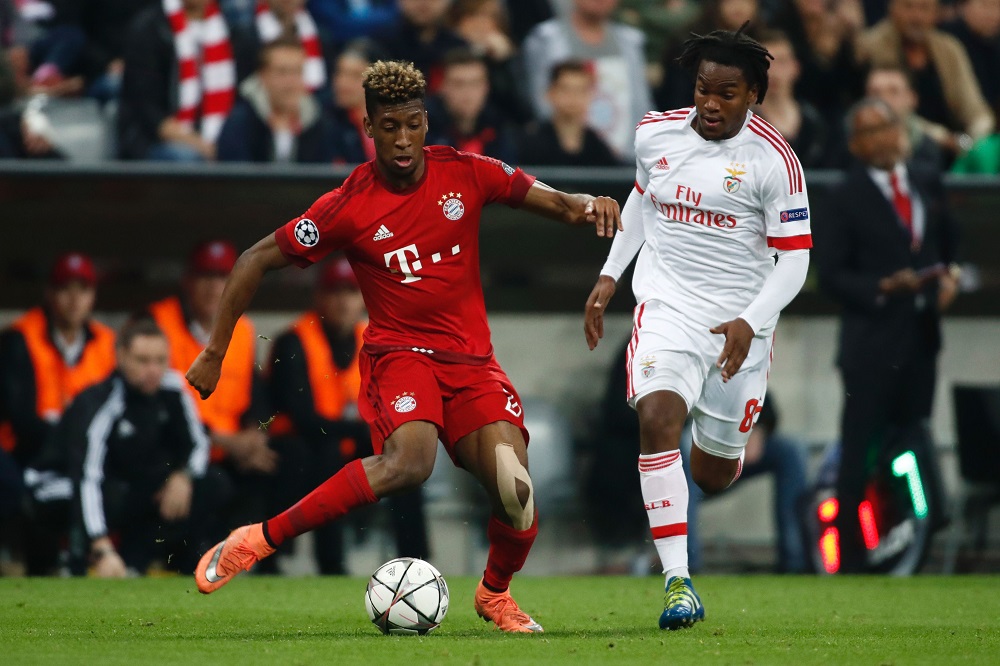
(Photo: ODD ANDERSEN/AFP/Getty Images)
Two on their way out, two more job sharing
On the other end of the spectrum, the 30-plus part encompasses the captain Lahm, the maestro Alonso and the wing duo Robbery. Ancelotti gave regular breathers to all four to keep them fresh for the run-in. As a result, none of these players have higher than a 75% share of the minutes.
Particularly the load on Lahm was clearly managed carefully. Until the 30th matchday, the right-back had played just 1,842 minutes in the Bundesliga. For the record, Lahm had only dropped below 2,000 minutes three times in his career – all three seasons saw him miss out for long periods through injury (05/06 cruciate ligament, 07/08 sprained ligament, 14/15 ankle).
The two wingers show a good example of successful job sharing. Ribery and Costa had an equal share of minutes, with Ribery, and thus the experience, coming into the important games against Real and Dortmund. Here we’ll have to wait and see whether Costa doesn’t agitate for more appearances in important games. Put bluntly, he simply didn’t deliver arguments for those appearances either in the Champions League or the DFB Pokal. It’s still up for debate whether he’s capable of making the vital next step in his development to replace a Ribéry in peak-form.
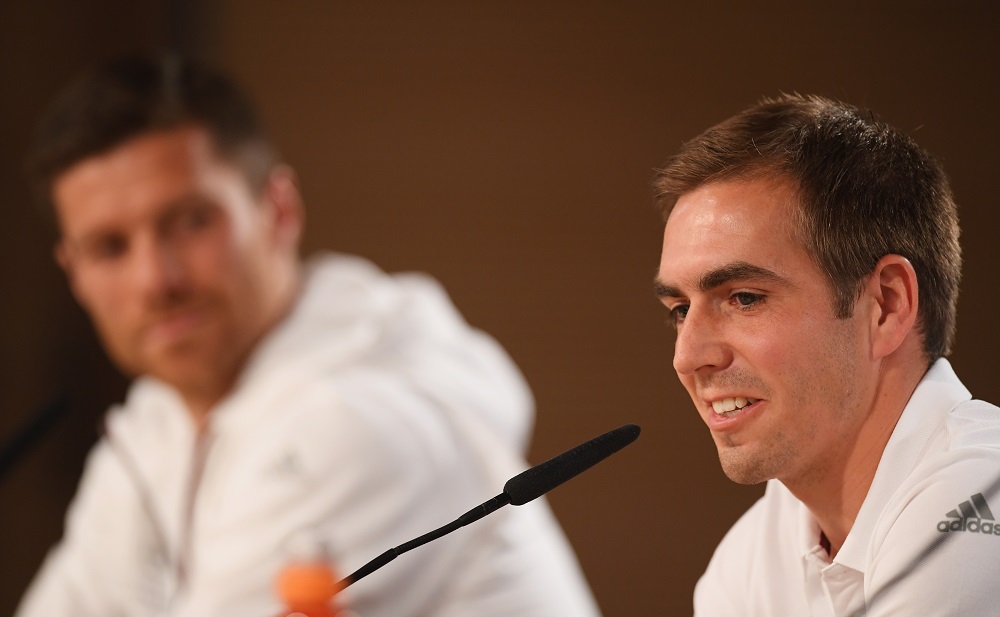
(Photo: Matthias Hangst/Bongarts/Getty Images)
Generation Bayern 2021
The remaining block is the area marked in red in the middle: the Bayern-2021 generation. Here we have Bayern’s best players from the current season: Lewandowski, Thiago and Neuer. All seven players, plus Boateng, who due to his injury falls somewhat short here, are also tied to Bayern long-term. Most recently Thiago extended his contract until 2021 before the game against Wolfsburg.
These players, supplemented with a few young players, should form the all-important spine of the team for the coming years. Many of them are on the brink of their absolute peak, or have already been at that level for a few years now. For Ancelotti it’ll be important to keep this spine together and happy. With the axis of Neuer-Boateng/Hummels-Thiago-Lewandowski, Bayern are set nicely until 2021. This group of players plus some choice players from Bayern’s own ranks, combined with some specific reinforcements, represent project Bayern-21.
Two players who stick out are Thomas Müller and Arturo Vidal. Müller was chasing his best form for the whole season, and only impressed seldom. His position, or rather the area that he occupied under Guardiola, doesn’t exist in Ancelotti’s 4-3-3. However, he was given a lot of game time, only coming on from the bench in the important games. There was no room in Carlo’s regular team for Müller.
Vidal is more or less on the same level as Alonso as far as playing time goes. After the Chilean showed his value to the team in big matches in the previous season, often Bayern’s talisman, his performances levelled out a little. Against the likes of Darmstadt, Vidal often lacked his spark.
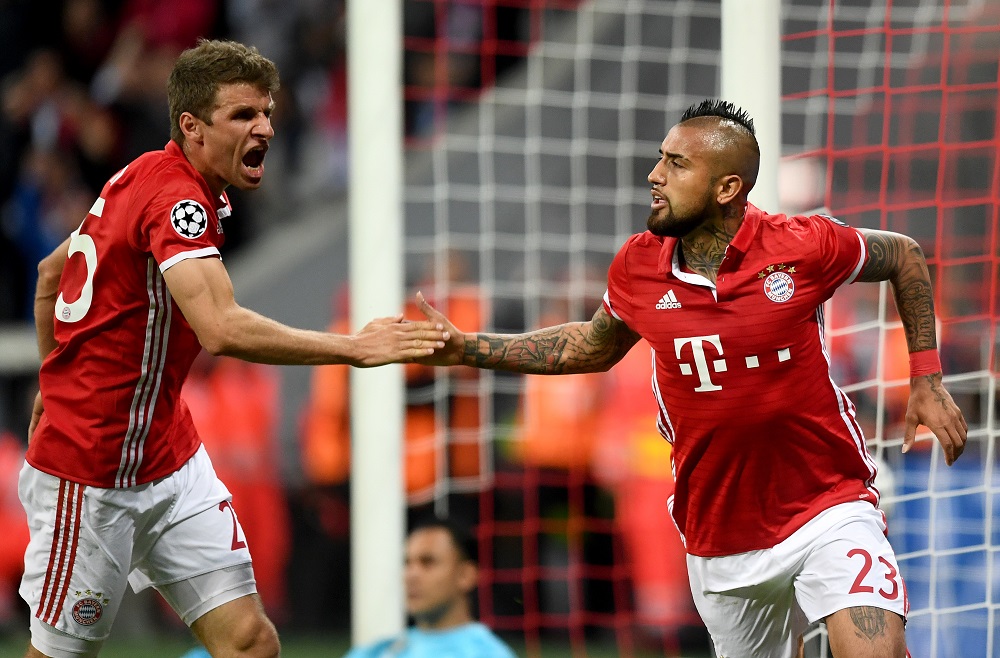
(Photo: Lennart Preiss/Bongarts/Getty Images)
After we’ve looked into the playing time of Bayern’s current squad, we’ll now shift our focus to national and international competitors.
To do that, the playing time was split into five age groups: U-20, 20-24, 25-29, 30-34, 35+. The competitors chosen are the two teams that destroyed Bayern’s treble dreams this season, and FC Barcelona.
Real and Bayern are fairly similar

In Germany, there is no other team that can become as dangerous to Bayern as Dortmund. After losing three key players in the summer – Hummels, Gündogan, Mkhitaryan – Borussia consciously chose to rebuild their team around young talents. Coveted talents like Dembele and Guerreiro signed for the club, as well as unpolished but promising Isak.
This youthful approach of BVB becomes visible instantly. In back-up goalkeeper Weidenfeller and Piszczek, only two players in their squad are above the age of 30. Dortmund puts much of their faith in key players at “ideal football age”. German internationals Schürrle and Reus fall into this category just like the returnees Sahin and Kagawa.
This group is supported by a large percentage of players under 25. In our comparison, no other team has this much playing time by U-20 players by a long shot. These tactics can pay off if players develop as planned and regularly get to collect experience at the highest level. At the same time, they do carry the risk of turning the club into a farming team for financially more potent clubs.
In international comparison, Madrid and Barcelona are closer to Bayern’s own age structure. Unlike Dortmund, neither of these teams has to rely on growing their own talent – if a young player from their own academies manages to make his way into their first teams, this is seen as a bonus more than anything else.
The split of playing time is almost identical for Real and Bayern; in Madrid, just like in Munich, key players are at the verge of turning 30. What’s interesting is that no player at Real has played more than 80% of all possible minutes this season. By comparison, Bayern has five players who achieved this in Lewandowski, Neuer, Hummels, Alaba, and Thiago.
In Varane and Carvajal, Madrid has two U-25 players with almost 70% of all minutes and have turned into regular starters. It seems that Real managed to conduct their squad turnover a little more smoothly than Bayern, although unlike the Munich team, they didn’t have undisputed starters in these positions previously.
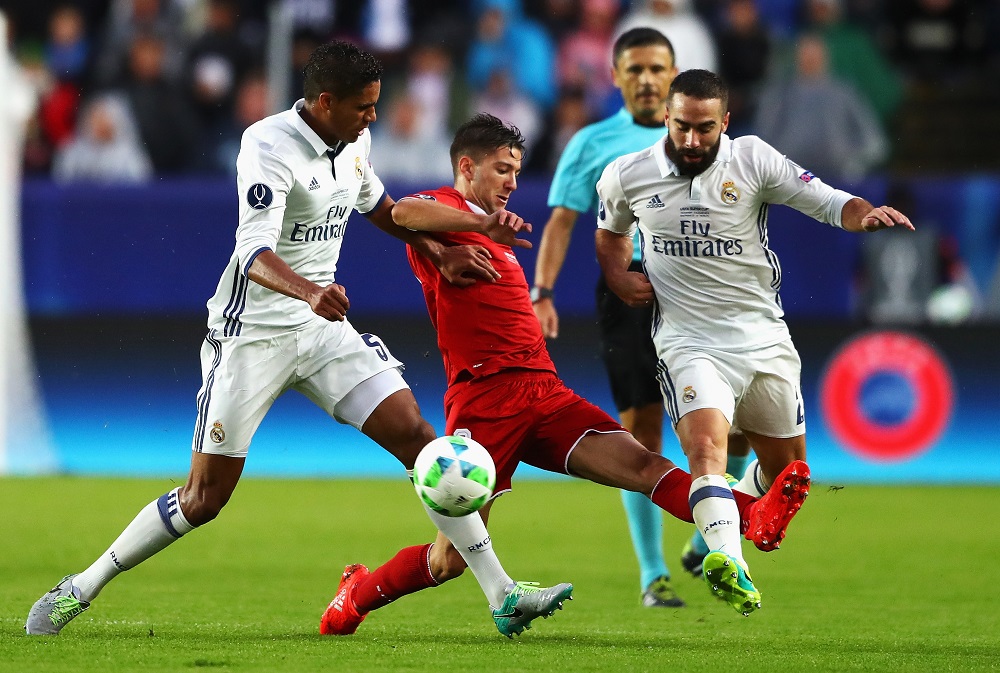
(Photo: Michael Steele/Getty Images)
The U-25 group is worth taking a closer look at: Barcelona are purposefully building up young players to join the first team. At 30%, this age bracket gets noticeably more minutes than at the other clubs in the comparison. However, players like Umtiti or Roberto haven’t turned into key players yet. The numbers are also slightly skewed by Marc-Andre ter Stegen, who, as a keeper, plays fairly regularly – on the position within the squad that is least dependent on age.
With the same approach, we will take a look at FC Bayern’s squad over the past years as well as previous teams Ancelotti coached in his past.
Therefore, we have chosen two seasons, in which those FC Bayern teams were able to win the Champions League trophy: 2000/2001 and 2012/2013. At first sight it already becomes quite clear that the age structure varies massively.
The Triple-team as the foundation of the current squad

The squad of the 2012/2013 season had an ideal age structure. The heart of the team with Schweinsteiger and Lahm as their leaders was around 23 to 28 years of age, which includes a bunch of players from Martinéz to Ribéry. You may need to add the only 20-year-old David Alaba, who already played a big part for the team. The minutes covered by players under 25 almost matches the playing time of the over 30-year-old players in the current season.
Most of the key players from 2013, besides Schweinsteiger and Dante, are still part of the squad today, which causes young talents to have very few appearances. The younger generation of that time did not manage to take the next step on a professional level. At least not at FC Bayern. Neither Weiser or Hojbjerg nor Can were able to convince to the fullest. However, Weiser would be a useful alternative, going into next season.

(Photo: Alexandra Beier/Bongarts/Getty Images)
Missing out on getting those players used to the competitive level of FC Bayern, is one of the reasons there is no academy player under 25 playing for the club today. This is one issue to reasonably criticize Pep Guardiola, who took over from Jupp Heynckes in 2013.
However, it seems quite hard to grant minutes to youth players with such a young starting XI at the time. Additionally, there is also a need of some sort of maturity to take on the challenge in a quality team like FC Bayern, which was obviously not existent at the time.
To compare the so-called experienced team of today it might be better to take a closer look at the squad, which managed to win the first Champions League title in the club’s history. There were players like Tarnat, Linke and Effenberg, who were almost beyond their peak. A lot of them, between 28 and 32 years old, had an incredible amount of experience on the highest level possible.
Nevertheless, Ottmar Hitzfeld also managed to include some young talents. Salihamidzic, for example, played for 80% of the possible minutes and Willy Sagnol at the same age had nearly as much appearances with 68% of the playing time. Both developed into big contributors in the following years. Even players under 20 like Hargreaves and Santa Cruz had some chances (20% of the possible minutes) to put themselves forward.
Ancelotti is able develop young players
To conclude we will take a look at the squads, Ancelotti coached when he won the Champions League title. Is it possible to notice a pattern? Does the Italian always count on experienced players?
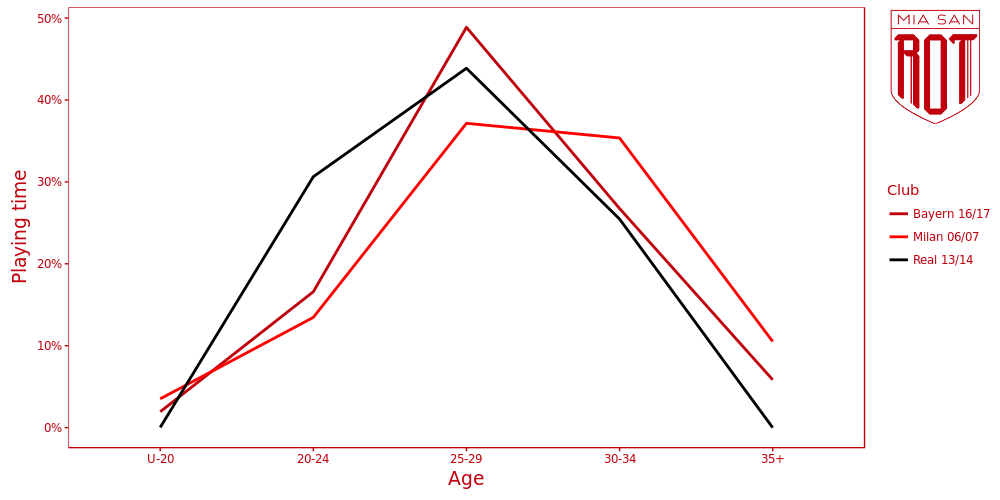
At first the assumption seems to be valid. Players with 30 to 34 years of age were playing around 20% of the possible minutes.
This makes his Milan squad similar to the current FC Bayern team. The generation around Maldini, Cafu and Inzaghi were taking on the challenge to make themselves immortal, with the help of many experienced players like Pirlo, Nesta and Seedorf (all in their late twenties). Kaka was, just like Thiago for FC Bayern, the key player for the future.
At Madrid, the team was just below their peak. He had some young potential at hand and adjusted the playing style in a suitable direction. However, the quality provided by players under 25 like Bale, Di Maria and Benzema (at the time), is not affordable for hardly any team in the world. All of them were able to improve under Ancelotti. Besides he could count on his stars between 26 and 28 years with the likes of Ronaldo, Modric and Ramos.
The oldest player at the time was Iker Casillas with 32 years of age. Alonso and Pepe were the only ones, who were 30 or even older with more than 50% of the minutes played. It is kind of surprising that Alonso had less playing time for Madrid than in the current season at FC Bayern.
Summary
Alongside players like Lahm, Robben and Ribéry the current Bayern squad has a second pillar with the likes of project 2021. The heart of the team should be able to stay together and perform on a top level over the following years. This is why a big change, like the media currently calls for, does not seem to be necessary right now. It will be much more important to identify the weaknesses of the squad and improve gradually.
The team, who has won the triple in 2013, almost stayed together, but now they have four more years of experience. Unfortunately, all of the young talents from 2013 were not able to take the next step, whereas the established ones became club-legends.
After considering Ancelotti’s past you may come to the conclusion that he likes to play with experienced players. However, the team of 2001 should be an example that too much focus on those players might be damaging to the success of the future.
Translators: Sam, Bettina, Luca



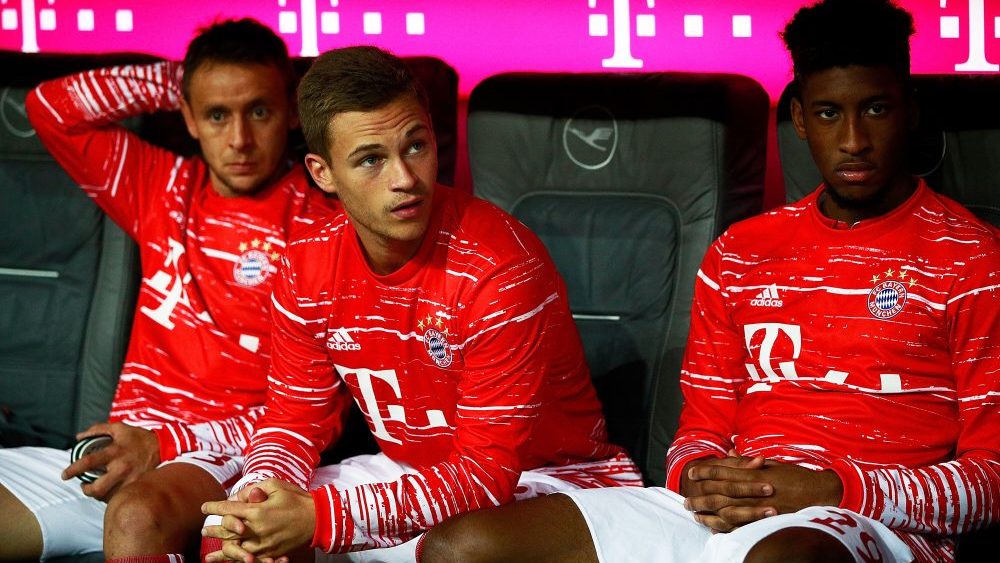








Interesting analysis. Thanks for compiling.